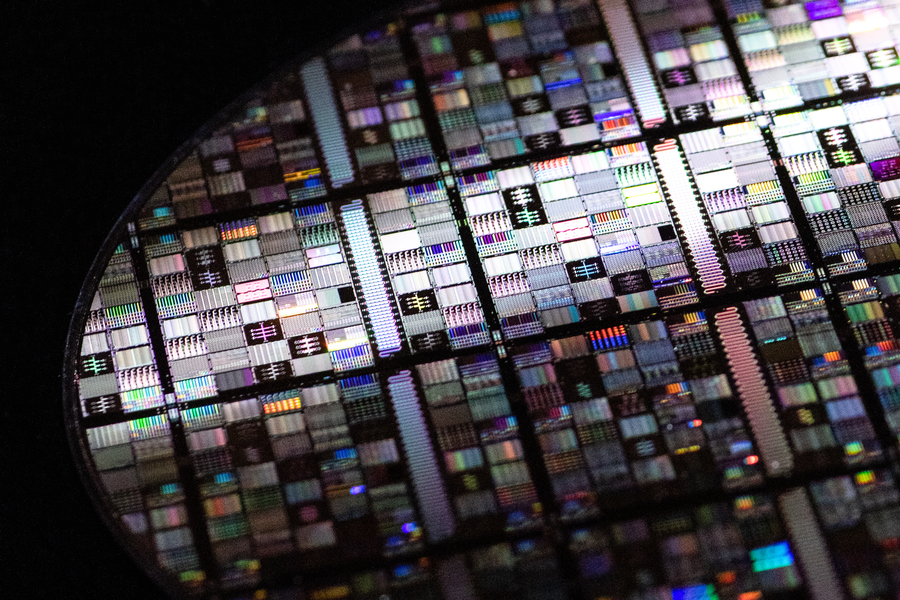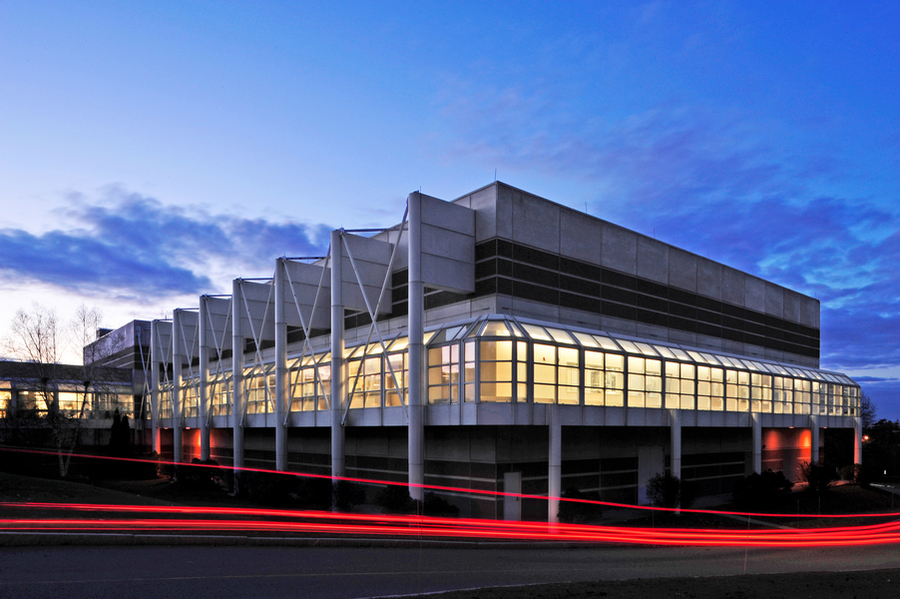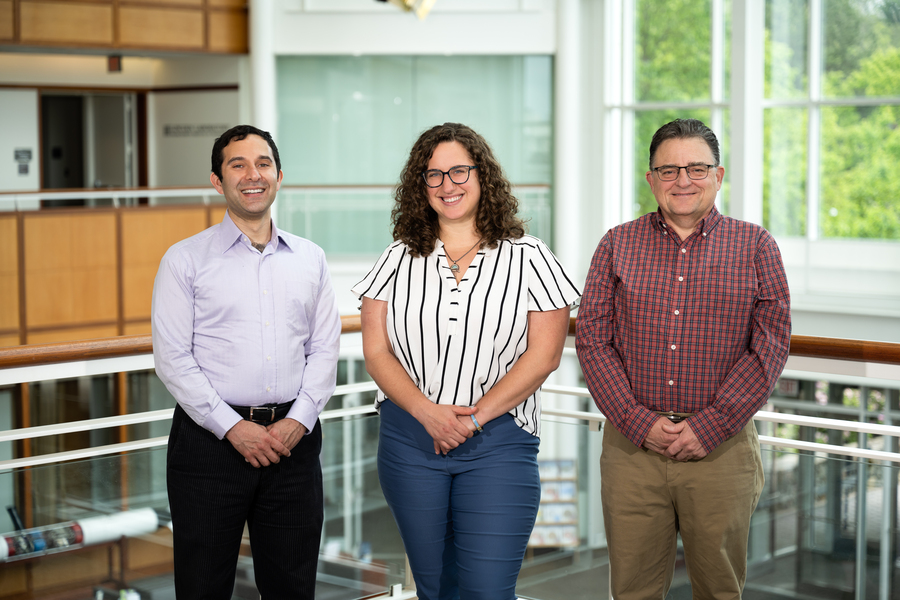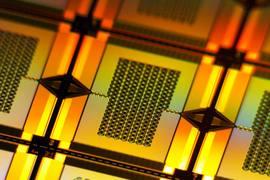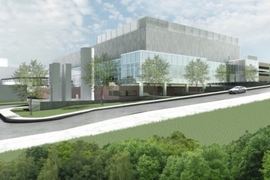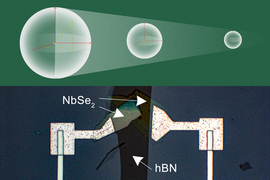In the past three decades, quantum computing has grown from a theoretical fantasy to a worldwide industry, pushing closer to a technology that could one day solve problems too complex for even the most powerful supercomputers. MIT Lincoln Laboratory is not only at the forefront of research, but is making quantum research accessible to a broader community through its Superconducting Qubits at Lincoln Laboratory (SQUILL) Foundry.
Quantum bits (qubits) are building blocks of quantum computers, like transistors are to classical computers. There are many ways of making a qubit; one of the most promising is superconducting qubits, which are generated by using circuits made out of superconducting elements. The qubits are fabricated using techniques similar to conventional microelectronics fabrication, such as depositing and etching thin metal films on a substrate. Then, they are operated at near-absolute zero temperatures to form “artificial atoms.”
Realizing the promise of quantum computing requires fundamental research and experimentation using these and other qubits. But superconducting qubits are tricky to build, and a major barrier for scientists wishing to pursue this research is the expensive tooling and specialized processes needed to fabricate the circuits.
The SQUILL Foundry was stood up to remove this barrier. Sponsored by the Laboratory for Physical Sciences (LPS) Qubit Collaboratory, a National Quantum Initiative-funded center, the program makes Lincoln Laboratory’s cutting-edge fabrication capabilities available at no cost to institutions working on U.S. government-funded research. Researchers can submit quantum circuit designs for fabrication, and the completed circuits are returned to advance scientific inquiry in their home facilities.
“Democratizing access to robust, reliable qubit fabrication dramatically lowers the barrier to entry in superconducting qubits,” says Mollie Schwartz, the principal investigator of the project and a leader of superconducting qubit research at Lincoln Laboratory. “We want to enable researchers whose core focus is not in materials and fabrication to really focus on driving progress in the areas of superconducting qubit research that they are most interested in, and to allow the community to leverage some of the more advanced capabilities we’ve developed.”
One foundry program user, Stanford University Professor David Schuster, says that the SQUILL Foundry has allowed his quantum lab to consider experiments they could not have attempted before because of the complexity of nanofabrication required. “It has allowed my younger students to design and measure complex quantum circuits much faster than they could in the past,” Schuster says.
An area of super-specialization
One of the chief advantages of superconducting qubits is their designability: Their dynamics and interactions are not dictated by nature, like those of a physical atom, but rather are designed by combining capacitors, inductors, and Josephson junctions (a type of superconducting switch) in creative ways to create the energy landscape of interest. Because of this designability, superconducting qubits represent a diverse family of quantum circuits, all of which can look different and behave in unique ways.
Advancing the state of the art in superconducting qubit hardware requires knowledge across a range of disciplines, including materials, fabrication, circuit design and simulation, packaging, cryogenics, low-noise measurement, hardware-software interfacing, and quantum compilation. As understanding of materials and processes has advanced over time, fabricating the highest-quality qubits increasingly relies on millions of dollars of fabrication equipment and countless hours of process development and sustainment.
“It has become increasingly challenging for individual organizations to maintain this full stack of expertise, particularly as circuits become more complex to design, fabricate, and measure,” Schwartz says. “As a result, superconducting qubit hardware research has remained centralized into a relatively small number of laboratories and large universities capable of developing and sustaining this expertise.”
MIT Lincoln Laboratory is one of these laboratories, with more than 20 years of research and development in superconducting qubits and demonstrations of world-leading qubit performance. The qubits are made on-site at the Microelectronics Laboratory, considered to be one of the U.S. government’s most advanced foundries, and in specialized prototyping facilities. The collective expertise and equipment of this facility have made it possible to stand-up the SQUILL Foundry.
From qubit design to delivery
The SQUILL Foundry first ran as a pilot from July 2021 to February 2023. The pilot program was made available to a preselected set of users who had a range of experience in the field, from long-standing leaders to new faculty, and including institutions with sophisticated fabrication facilities and those with limited fabrication or no fabrication resources.
Users received a design rule guide and samples of physical layout files to provide a starting point for their designs. They also received a high-quality “candle qubit” chip that allows the users to qualify their at-home quantum measurement apparatuses. “It’s a chip that we’ve already done measurements on, and then they can measure the same chip in their systems to make sure that those systems are meeting expectations,” says Cyrus Hirjibehedin, who led user interactions for the project. “Overall, the process has gone very well, and we’ve received overwhelmingly positive feedback from our users.”
Users submitted custom designs to the SQUILL Foundry and received back fabricated devices wire-bonded into cryogenic packages. Users then leveraged these devices for scientific inquiry, resulting in 13 presentations and four scientific papers in preparation or print, with more to come as research proceeds.
“There is certainly a learning curve when you are used to fabricating devices in-house, but the support and information provided by the foundry to aid users in the process has been phenomenal,” says Professor Machiel Blok, who runs a research group at the University of Rochester. The foundry helped his group overcome a years-long delay, caused by the pandemic, in fabricating quantum processors at their facility.
Professor Kater Murch from Washington University in St. Louis, Missouri, says that participating in the program allowed his team to design, set up, and measure devices far beyond their normal capabilities. “We’re just finalizing initial results from our first projects, but the work we’ve done in the lab to get our devices to work puts us several years ahead of where we would have been without the program,” Murch says.
In parallel, the laboratory worked to transition its qubit fabrication process from 50-millimeter prototyping wafers (the substrate on which the circuits are fabricated) to 200-mm production-scale wafers. “In addition to giving us more real estate on the wafer, the transition allows us have better process control and to use automated equipment and cleaner resources, with less direct human wafer handling,” says Jeffrey Knecht, the SQUILL Foundry fabrication lead.
Opening the doors to the research community
Building on the success of the pilot, the SQUILL Foundry is transitioning to a full four-year project, opening the doors to the broader research community in a by-application access model that is available to any sponsor-approved superconducting qubit research project supported by a U.S. government grant.
“Qubit chips from the Lincoln Laboratory foundry effort have already helped nine research groups across the country realize their ideas and accelerate their research,” says Charles Tahan, the director of the LPS Qubit Collaboratory. “LPS is pleased to support the expansion of the Qubits for Computing Foundry program to bring world-class qubits to many more researchers and students.”
The full-scale foundry will roll out more advanced capabilities, including compact arrays of Josephson junctions and flip-chip integration (a compact method of connecting multiple circuits), to enable more advanced qubit designs. Additional capabilities will be developed with user input and made available as the SQUILL Foundry program proceeds, to ensure that the foundry continues to meet the evolving needs of the community.
More than 20 research groups are poised to leverage the foundry as the access model expands, and this number is expected to grow over time. Schwartz says she is especially interested in exploring paths to work with schools that do not have the resources to purchase and maintain fabrication equipment.
“There are incredibly talented and creative students across the country who cannot currently participate in superconducting qubit hardware research, but whose discoveries might change the way we think about this technology. Lowering the barrier to entry will enable some of these institutions to stand up superconducting qubit research groups, which will help expose more students to quantum research and expand our workforce as the industry grows,” Schwartz says.
Those interested in working with the SQUILL Foundry can reach out for more information at SQUILLFoundry@ll.mit.edu.
